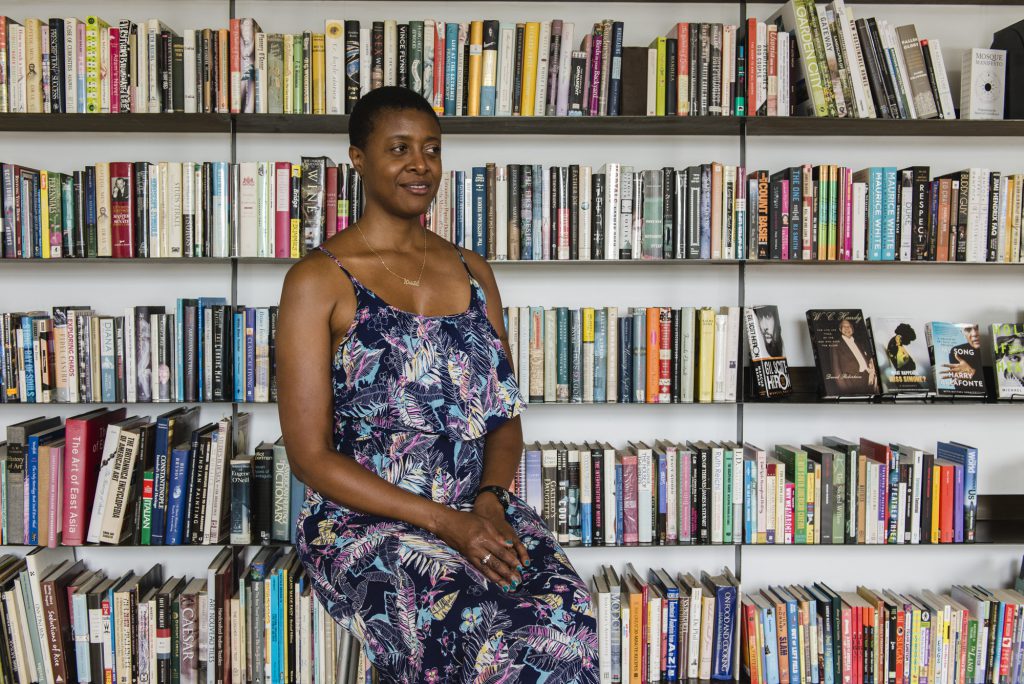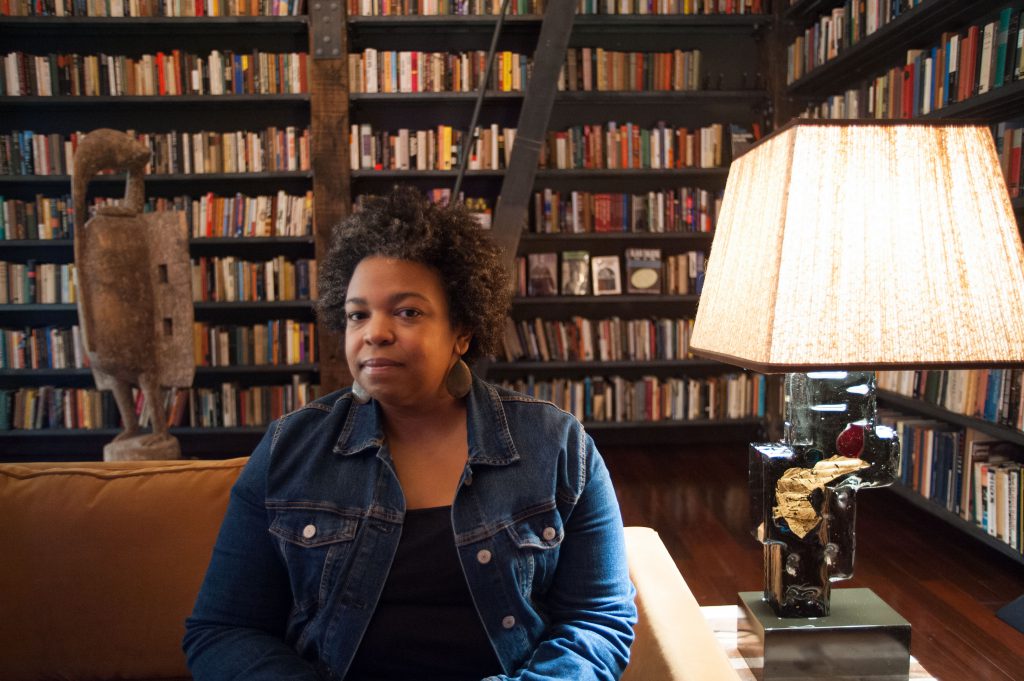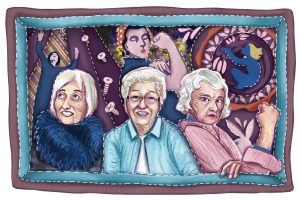“We had so many good times. I grew up with Johnson,” a fellow visitor to A Johnson Publishing Story told me of the more than fifteen years she had spent working with the Johnson Publishing Company. As we took in the many books and objects on display from the Johnson Publishing Archive, she shared how she had started as a young secretary on Johnson’s executive floor, then worked as an executive secretary for the company’s children’s publication Ebony Jr., before going on to serve as a Midwest director for community relations, visiting Black churches and other institutions in Oklahoma, Missouri, and beyond to promote Johnson Publishing subscriptions and charity initiatives. And when we stopped in front of a zippy red alligator embossed vinyl-sheathed typewriter, I was surprised by how evocative such an object could be when she remarked, “Oh, I remember these! IBM at the time made these Selectrics in black, steel gray, and putty, but Johnson had them made custom in red alligator. I hammered away at one just like this.”
John H. Johnson started his publishing company in Chicago with Negro Digest in 1942, and the Johnson Publishing roster quickly expanded with Ebony, Jet, Hue, Tan, Ebony Man, and Ebony Jr., building an incredibly successful business around African American concerns and culture. Johnson wanted to portray the richness of Black life: “Ebony is a magazine devoted to making people feel good, making people proud of their heritage. The first time I saw a Black person in print in a tuxedo was in Ebony. The first time I ever saw a Black wedding was in Ebony.” Johnson publications like Ebony chronicled and promulgated Black culture and aesthetics across the nation and around the world; soon, the scope of the company expanded to book publishing, radio, television, and the vaunted Ebony Fashion Fair. A Johnson Publishing Story, on view at the Stony Island Arts Bank through September 30th, captures the Johnson Publishing Company’s influence from the vast archive of material culture generated in the enterprise’s decades-long work, from the red alligator IBM Selectric to back issues of Ebony, Jet, and Negro Digest; African statuary from Johnson’s collection; velvet couches, a desk, and shaded lamps from the iconic Johnson Publishing Building; and the thousands of books from the Johnson Library collection donated to the Stony Island Arts Bank. Each object resonates with the ideas, efforts, and taste of those like the woman who shared her memories with me who have worked under the mantle of this Chicago-based institution.

These continued resonances are on view through responses made by contemporary artists to Johnson Publishing’s impact, including David Hartt’s photographic series Stray Light. I had the privilege to explore the deep-seated significance of this material culture in conversations with Chicago-based artists Samantha Hill and Krista Franklin. As an artist and archivist, Samantha Hill stewards histories and memories that have been shared with her and that she has collected into material narratives. Hill’s installations communicate in many mediums – archival materials, tintypes, video, performance, scent, oral histories, spatial environments – the interplay of personal, lived experience within a wider history of a community, like those of Bronzeville’s Renaissance or the Double Oaks neighborhood in Charlotte, North Carolina. In Hill’s methodology, the archive becomes not only an artistic product but an invitation to the audience to open their own inquiries. Krista Franklin’s visual and poetic work both metabolize and venerate the histories, images, memories, and mythologies of women, people of color, Black people, and the African Diaspora. Franklin employs processes of collecting, abstraction, poetry, collage, handcraft, commercial imagery, and bookmaking to collide the radical and the emotional. Imagination is not sui generis in Franklin’s practice but, whether through the lenses of Afrofuturism and AfroSurrealism or otherwise, stems from collective sources. The works of Hill and Franklin differ widely but I appreciate that each, in their own way, finds consonance with their art and historical content.

A Johnson Publishing Story prompts us to approach history in a way that honors material culture, this comes across clearly in an exhibition space environment that revitalizes Arthur Elrod’s design vision for Johnson Publishing Company offices. “Objects come with a kind of history embedded in them, the people that touched them, the people that loved them, the people that purchased them, the way that they’ve been arranged in a space – they carry their own histories. Even this sofa that we’re sitting on, many illustrious people have probably sat on this furniture; we’ll never know that but the sofas know it, the chairs know it, the statues know it,” says Franklin. Access to materials from the Johnson Publishing Archive, to share their space and interact with them, affords the opportunity to construct our own narratives as we to try to “read” these objects for the information contained within them. The exhibition’s signage asks us to recognize the displayed objects as sacred, and, indeed, the objects in and of themselves elicit a particular comportment from me and the other visitors I’ve observed. Hill characterizes this attention to the materials in noting that, “You can look but you can’t touch because these objects are fragile, but I think that barrier also allows for respect and reflection…Walking into the exhibit stimulates mood, the fact that the collection is not brightly lit under fluorescent lights – it’s not sterile, it’s warm, its intriguing – that gives you that moment to really reflect on what it is you’re looking at.” Our curiosity is made manifest as we take in the Johnson Publishing tableau.
Most of us know that archives exist but rarely have the chance to interact with them in daily life. In observing the breadth of materials on display from the Johnson Publishing Archive, I wonder if archive-making provides us with tools for how we may assimilate history and feel a sense of ownership for it. These are questions that Hill asks in her practice; as she tells me, “I think the archive and material culture are important because something is lost when everything is digital – it’s very ephemeral and disposable. When you actually have a book or a paper photograph or an object, you start to notice how people communicate in a certain period of time and that also becomes tangible.” The challenge that Hill has set for herself is to balance her authorial frame with the impulse to engage the public in activating an archive on their own terms. Hill shares what she has learned from a wealth of experience: “As an art practice, I want people to probe and form their own inquiry…I’ve put a hundred-year-old book in a ten-year-old’s hands and they light up: first, there’s fear – they know it’s special and they’re like ‘oh my god, I’m going to break it;’ then you teach them how to gently handle it, how to gently touch the pages with these pristine white gloves – now there’s another barrier so they know something special’s occurring; then there’s this moment of transcendence when they really reach into the material culture and they take it very seriously and they take in all the senses –the way that the book smells, the way that it feels, it’s weight, the way that it’s faded, the pictures, the text – they take it all in; and, not only that, when it’s time to give it back they will close it gently and they will hand it back to you like it’s a ritual. I’ve seen this so many times, that’s why I love opening up the archive and having a hands-on experience with my public because I can learn a lot from that, too.” Hill’s ongoing Kinship Project, at once deeply personal and collaborative, explores how people frame their own stories within local histories. Through engaging in many conversations and receiving donations of personal collections, Hill has found a common drive: “Who is kin? Who is family?” You have the family you’re born with, the family you create, and the societal structure.”

Maintaining an archive is itself a process of restoration, not only of physical preservation, but of the image and its meanings, thereby restoring a community’s history and restoring that history for all of us. It is no wonder to me, then, that the Johnson Publishing Company was so successful because I see that care for both material object and self-image writ large in the exhibition. The vast archive of printed matter produced by the Johnson Publishing Company has proved fertile ground for Franklin to construct visual, mythic, politic spaces for the viewer to inhabit: “In the visual work that I do, and in particular the handmade paper and collage work which sources heavily from Jet, Ebony, and Johnson Publishing, the information is embedded in those objects, so if I tear a page out of a vintage Jet magazine, it already contains so much information – not just what’s printed on the page but also the care that was taken for the writer to write whatever text is on the page, and whoever took the photograph. It already carries within it all of this information so I’m adding on to and layering and working within what already exists, trying to pull together different sources into one space and allow people to make whatever assessments, thoughts, ideas surface within them, and have that be a very personal experience.”
The perpetuation of material culture, its richness and complexity, counteracts the urge to simplify that pervades our contemporary society. Society most often conceives the temporality of imagination as looking forward into the future, but we are well served to look back and interpret what came before. Steeped in Octavia Butler’s novel, Parable of the Sower, Franklin has embedded Ebony, Jet, and Vibe magazine pages in handmade paper in her recent work, “…to take root among the stars,” in a gesture, “to record the legacies of what we now call Afrofuturism and AfroSurrealism…Capturing where those evidences show up in the printed matter of Johnson Publishing Company was a wonderful archival process – this is old information, this is not new. We’re building on foundations that have already been set.” Those foundations, made palpable in A Johnson Publishing Story, convey an experiential imagination, and the desire to speak to a whole community, and not just to them but with them. The question of communication, vital to an artistic endeavor, is taken up by Hill: “To be perfectly honest, it’s not just the art world that I’m talking to, it’s the world that I want to talk to so I have to make [my work] as accessible as possible for people to engage with. And that’s what I think Johnson’s plan was, he wanted to speak to the world, he wanted to show the beauty of the Black experience, he wanted to show the beauty of the human experience, and he created all those periodicals, and he collected all these things. I think he does want people to still look through them, flip through them, and have a conversation.”

Franklin expresses the imaginative value she has found in Johnson publications by telling me, “I’ve always been a magazine hoarder, what I call a magazine whore, and since I was a kid that’s what I had around me to make images. And I had a rolodex of images in my head, iconic photographs – shout-out to the photographers because that’s the basis of my work, to riff off of theirs – from looking through magazines as a kid and in my early twenties and being completely infatuated with the publishing world and with the fashion and music worlds. So everything I’m doing is in homage to that, in homage to this visual culture that existed in my head.” The representations contained in visual culture become a part of how we see ourselves, and, as Franklin described of her own experience, spurs self-awareness. “My first introduction to the word representation was my family telling me: ‘Do not misrepresent us when you go out into the streets.’ So representation in my mind as young person meant that’s how you portray yourself and that how you come across is about how people perceive you. And when you represent in the hip hop context or in the vernacular of hip hop, your rep is something, you’re showing up for an idea, a group of people, you’re representing. That term has always been deeply connected to community or to communities or to families, it’s not just me that I’m representing, it’s a whole bunch of people who are standing with me and behind me, people who came before me.” Franklin’s assessment made clear for me the possibilities of representation as a process of amplification, a process clearly perceptible in the issues of Jet, Ebony Jr., and others that are accessible in this exhibition.
Hill relates her early encounters with Johnson publications and how she interpreted them: “I remember as a kid my mother had Ebony and Jet. I was all into Ebony and I didn’t understand Jet – in the mind of a ten-year-old who wants to look at this beautiful fashion magazine, while this other one is talking about culture and politics – I knew it was important because my father was reading it but I didn’t feel it was quite for me yet. When you think about the Black experience, it is multi-layered, rich, complicated, sophisticated, authentic, and one publication couldn’t capture all of that, so Johnson had to make many. Maybe at first he thought of the magazine produced by people of color for people of color and then he probably realized that he couldn’t [accomplish that], and that’s where the richness came.” Popular culture often functions through a totalizing effect – this is the one way we are going to read an event, a person, a Black person, a kind of music – and the Johnson Publishing Company conscientiously worked to counteract that effect and to also create a vision of society and culture that was parallel to the prevailing forms and content. This vision was, and still is, disseminated far and wide across the country and around the world. Franklin says that she came to understand the impact of the Johnson Publishing Company’s scope in, “thinking about Emmett Till and the publishing of those photographs [taken by David Jackson and reported by Simeon Booker in Jet] that had such an impact on the nation – the courage that it took for Johnson to demand it. It still reverberates today with just as much tragedy and outrage. My understanding of Johnson Publishing Company as this Black historical institution didn’t happen till much later in my life, but the Ebony magazines were always present, Jet magazine was always present, it was just always something in the environment, in the domestic spaces I went in and out of that were Black. It took me a while to realize the impact of what Johnson Publishing Company did, what they constructed, how they were really thoughtful about establishing what is Black culture: this is who we are, aspiration for a kind of Black middle class or bourgeois existence, education, informing ourselves about what’s happening in the world, what’s happening with our people.”

I am struck by the real resources Johnson Publishing Company needed to harness to attain such a pervasive reach in our society and imagination, and the resources necessary to preserve that material legacy. Hill responds to these inquiries from her own creative interrogations: “Johnson was a businessman, so he could think strategically about how to build capital and produce something, inspire, educate, document, and create a new experience. My collection started from the artistic impulse, and then with every image that I collect, it inspires and draws me in and I need to research more, find more. The veil of interpretation becomes curious to me, how are we alike and how are we different.” Franklin, in turn, proceeds from her notion of a collective consciousness which she employs in writing and making objects: “to make something that impactful you have to have many hands in the process – many hands, minds, ideas, expertise – and there’s’ something really profound in making something in collaboration with community.” Spending time in A Johnson Publishing Story, I perceive the care with which designers, photographers, writers, editors, typesetters, secretaries, and others working in the Johnson Publishing enterprise communicated with the world. The emotional content embodied in the Johnson Publishing Archive endures such that artists, and any of us, may open narrative and imaginative inroads into history.
This article is presented in collaboration with Art Design Chicago, an initiative of the Terra Foundation for American Art exploring Chicago’s art and design legacy through more than 30 exhibitions, as well as hundreds of talks, tours and special events in 2018. www.ArtDesignChicago.org.
Featured Image: The artist Samantha Hill and the author sit on a sofa in an orange-walled room that features a neon artwork, African statuary, furnishings, and ephemera from The Johnson Publishing Company’s archive in A Johnson Publishing Story exhibition on view at the Stony Island Arts Bank. Photo by Tony Smith.
 Noor Shawaf is a freelance editor, most recently on Making All Black Lives Matter: Reimagining Freedom in the Twenty-First Century by Barbara Ransby (University of California Press, 2018), and an editor for Sixty Inches From Center. Noor is a staff member of the National Women’s Studies Association.
Noor Shawaf is a freelance editor, most recently on Making All Black Lives Matter: Reimagining Freedom in the Twenty-First Century by Barbara Ransby (University of California Press, 2018), and an editor for Sixty Inches From Center. Noor is a staff member of the National Women’s Studies Association.




